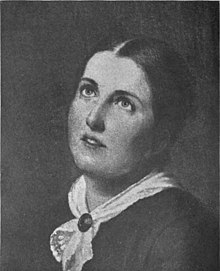Julia R. Anagnos
Julia R. Anagnos | |
|---|---|
 Julia R. Anagnos, from a 1907 book | |
| Born | Julia Romana Howe March 12, 1844 |
| Died | March 10, 1886 (aged 41) Boston, Massachusetts, U.S. |
| Occupation(s) | Poet, educator |
| Spouse | Michael Anagnos |
| Parent(s) | Samuel Gridley Howe Julia Ward Howe |
| Relatives | Maud Howe Elliott, Laura E. Richards, Florence Howe Hall, Henry Marion Howe (siblings) |
Julia Romana Howe Anagnos (March 12, 1844 – March 10, 1886) was an American poet, daughter of Samuel Gridley Howe and Julia Ward Howe.
Early life
[edit]Julia Romana Howe was born in Rome, Italy, to American parents Samuel Gridley Howe and Julia Ward Howe, on their extended wedding trip in Europe.[1] She was christened in Rome by Theodore Parker, her parents' friend from Boston.[2]
Both of her parents were well-known figures in Boston and beyond; her father was an educator who distinguished himself in the Greek War of Independence, while her mother was a writer and suffragist, and wrote The Battle Hymn of the Republic. Her younger siblings were also noted in their fields, as writer Florence Howe Hall, scientist Henry Marion Howe, writer Laura E. Richards,[3] and writer Maud Howe Elliott.[4] Her uncle was lobbyist Samuel Ward,[5] and her nephew was writer Francis Marion Crawford.[6][7]
Career
[edit]Anagnos worked at her father's school, Perkins School for the Blind, as a teacher. When her husband became the school's director in 1876, she also took on greater responsibilities at the school.[8] Laura Bridgman, her father's deaf-blind student, took particular interest in young Julia, and they formed a lasting friendship.[9][10]
In 1884,[11] Anagnos was a founder and president of the Boston Metaphysical Club.[12][13][14] "She walked in a dream always, of beauty and poetry, thinking of strange things," her sister recalled.[3]
Anagnos published a volume of her poetry Stray Chords (1883),[15][16] and Philosophiæ quæstor = or, Days in Concord (1885), a book about Bronson Alcott's Concord School of Philosophy.[12][17] She also translated Brief account of the most celebrated diamonds (1880) from German.[18]
Personal life
[edit]She married her tutor, her father's Greek-born assistant Michael Anagnos, in 1870.[19] She died in 1886, aged 41 years, in Boston.[14] Annie Sullivan mentioned Anagnos's recent death in her valedictory address at Perkins in 1886.[20] Anagnos Cottage, at Perkins, is named for Julia R. Anagnos.[12]
References
[edit]- ^ Schriber, Mary Suzanne (1989). "Julia Ward Howe and the Travel Book". The New England Quarterly. 62 (2): 264–279. doi:10.2307/366423. ISSN 0028-4866. JSTOR 366423.
- ^ Howe, Samuel Gridley (1909). The servant of humanity. D. Estes. p. 156.
- ^ a b Richards, Laura Elizabeth Howe (1895). When I was Your Age. Estes and Lauriat. p. 14.
- ^ Grinnell, Nancy Whipple (2014-01-07). Carrying the Torch: Maud Howe Elliott and the American Renaissance. UPNE. ISBN 978-1-61168-495-7.
- ^ Jacob, Kathryn Allamong (2010). King of the Lobby: The Life and Times of Sam Ward, Man-About-Washington in the Gilded Age. JHU Press. ISBN 978-0-8018-9397-1.
- ^ Trent, James W. (2012). The Manliest Man: Samuel G. Howe and the Contours of Nineteenth-century American Reform. Univ of Massachusetts Press. ISBN 978-1-55849-959-1.
- ^ Dole, Nathan Haskell (February 1910). "Julia Ward Howe and her Talented Family". Munsey's Magazine. 42: 613–620.
- ^ Sanborn, Franklin Benjamin (1907). Michael Anagnos, 1837-1906. Wright and Potter printing Company. ISBN 978-0-7950-0394-3.
- ^ Howe, Maud (1903). Laura Bridgman. Little, Brown & Company. p. 172.
- ^ "Laura Bridgman". The Wichita Beacon. 1887-01-24. p. 2. Retrieved 2021-09-08 – via Newspapers.com.
- ^ "Untitled news item". The Buffalo Commercial. 1884-03-24. p. 2. Retrieved 2021-09-08 – via Newspapers.com.
- ^ a b c "The other Anagnos". Perkins School for the Blind. 2019-12-12. Retrieved 2021-09-08.
- ^ Boston Metaphysical Club (1886). Memorial meeting. Proceedings of the Metaphysical club, at a meeting held March 24, 1886, in memory of its late president, Julia Romana Anagnos. Boston: Press of Henry H. Clark & Co. OCLC 11997022.
- ^ a b "The Late Mrs. Anagnos". The New York Times. 1886-03-20. ISSN 0362-4331. Retrieved 2021-09-08.
- ^ Anagnos, Julia R. (1883). Stray Chords. OCLC 7790064.
- ^ Anagnos, Julia Romana Howe (1883). Stray Chords. Cupples, Upham.
- ^ Anagnos, Julia R. (1885). Philosophiæ quæstor = or, Days in Concord. Boston: Lothrop. OCLC 1264240.
- ^ Anagnos, Julia Romana Howe (1880). Brief account of the most celebrated diamonds. Tr. from the German. Boston: Howe Memorial Press Perkins Institution and Mass. School for the Blind. OCLC 16015584.
- ^ "Michael Anagnos (1837 - 1906)". AHEPA History. Retrieved 2021-09-08.
- ^ Nielsen, Kim E. (2009). Beyond the miracle worker: the remarkable life of Anne Sullivan Macy and her extraordinary friendship with Helen Keller. Boston: Beacon Press. p. 69. ISBN 9780807050507.
External links
[edit]- A letter written by Julia Romana Howe to her uncle, Samuel Ward, March 1880, in the New York Public Library's Digital Collections
